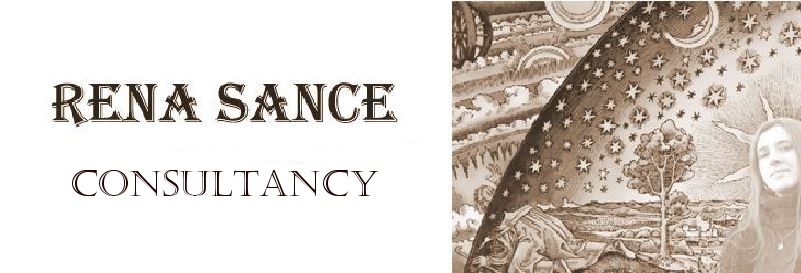The Wheel of the Year
The Wheel of the Year is an universal map of the year, an universal calendar that may be used as a compass, a timely mandala, presenting the combined aspect of space and time.
As western astrology has been invented in the Middle East, the so-called cradle of civilisation - and spread and developed through ancient Greece, Rome and Renaissance Europe - the Wheel of the Year relates to the European Northern Hemisphere and its specific cultural and natural background.
***
Now, right where you are, face the direction when the Sun shines around noon each day - where it is at its highest and brightest position. This is South. On your left is East, on your right is West, behind you is the North.
(Geographical maps reverse the directions - North is up and South is down, East is left and West is on the right side).
 |
| Calendar Wheel © Rena Sance |
The Sun journey through a year correlates to its journey through a day:
We have sunrises in the East.
Midday Sun, at noon, is always exactly at the South.
Sunsets are in the West.
Sun disappears below the horizon for the night. Nevertheless, we know what midnight is and this relates to the North.
On Spring Equinox (21-23 March) and Autumn Equinox (21-23 September) (see above) the Sun rises over a horizon exactly in the East, and sets exactly in the West direction, (the days and nights are of equal length).
On Summer Solstice (21-23 June) it reaches its highest point during the year, and it always happens where South direction is. (And this is the longest day and shortest night)
On Winter Solstice (21-23 December) it reaches the lowest point during the year. (And it is the shortest day and the longest night).
So, during the Summer (in the Northern Hemisphere), the Sun reaches its peak - as it does during the midday.
Things get a bit complicated in the East and West as the Sun changes its sunrise and sunset positions almost every day. For this we have the excellent invention of the Celtic festivals. More on it below.
***
The Wheel of the Year is an astrological mandala representing a year as a cycle, and life as a cycle: We start our journey on Earth through the East gate. We go through childhood (Spring), youth (Summer), adulthood (Autumn) and old age (Winter).
The Tree of Life depicts the changing seasons, the different phases of plant-based life. Every form of more complex biological life exists here on Earth thanks to the plants and their interaction with the Sun.
The sacred tree is present in many cultures and it symbolizes the backbone of life - Axis Mundi.
It has always been important for us, humans - to keep up with the right time. It is not possible to know what the date is - without a proper calendar.
Many megalithic structures around the world show to what extent the ancient people had gone to simply measure time. Most of those structures relate to the movements of the Sun, Moon, planets and stars.
The time they were built relates to the invention of agriculture in Neolithic times. Farming required the precision of time - when to saw and when to reap. It may seem easy for us now but this had been a matter of vital importance.
The most famous of all those structures is Stonehenge in England.
 |
| Stonehenge - one of the earliest ceremonial sky observatories |
It has been carefully studied in recent decades, and there are some neat conclusions to be drawn.
Because the South of England is in a different attitude and longitude than the Middle East, the belt of the Zodiac was not used in creating the stone calendar. Yet the movement of the rising and setting Sun against the backdrop of constellations is at its root, and the circular shape is employed.
The remnant of this Stonehenge-calendar-system is most probably the Celtic calendar. It divides the year into four parts marking the changing season in the Northern regions. It corresponds to celebrations of four festivals:
Samhain (1 November) (Halloween)
Imbolc (1 February) (Groundhog Day)
Beltane (1 May) (May Day)
Lughnasad (1 August) (Lammas).
 |
| Summer and Winter Solstices are the most common calendar-making markers |
It was not hard to realize in those primaeval times that 'the spirit of life' dwells in the greenery.
The plants, and the most robust of them - the trees, had been used to understand the magic of the cycles of life. The vegetation process throughout the year is the basis for the formations of many mythologies and religions - and of Western Astrology.
 |
| The Green Man is the symbolical spirit of Plant Life |
In the Celtic tradition, it is the Green Man that is chased around the circle of the year, through its different stages, from his birth, youth, maturity, upcoming death and the annual return.
The ancient had seen that part of the soul of the dead ancestors becoming the grain, the seed, the egg - staying in the landscape or in new generations - forever - through the ever re-occurring dance of life, bounding the family and tribe with the land and every little thing in it.
Of course, Christianity derives a lot of symbology and tradition from the many aspects of the Pagan depictions of this life-cycle. Because it is natural.
So, Time is seen as a cycle - a circle - in its two dimensional representation. However we are not going round in circles - Time has a linear aspect to it - and we all know it well.
How to combine a circle with a line? It is a spiral. Even more precisely - it is a spring spiral:
 |
| The spiral is one of the most common ancient symbols and a perfect depiction of the circular and linear nature of Time. |

